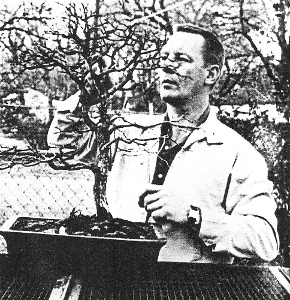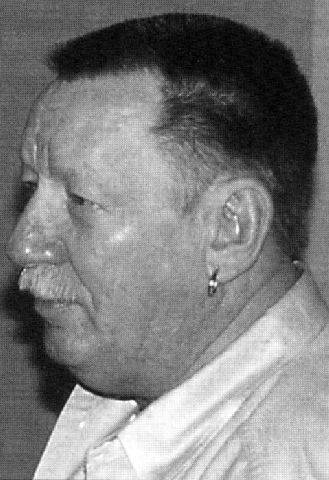| 1 |
1938 -- Jorge Lucio Lucero was born in Cordoba, Argentina. [He would move to London,
England in 1963. During the mid-1960s, his interest in bonsai would start
to develop after visiting the Chelsea Flower Show there. In the late 60's
following visits to New York, California and Florida, he would establish his residence
in Florida. His experience would grow after apprenticeships and tutoring under
such masters as John Y. Naka, Toshio Saburomaro, and many others. Since 1973
Jorge would be conducting lectures and workshops throughout the southeastern United
Sates, and since 1975 throughout Central and South America, including Mexico, Costa
Rica, Argentina, Bolivia, Brazil, Colombia, Peru, and Venezuela. He would be
instrumental in several of these countries with the formation of their first bonsai
societies. A professional lecturer, teacher and instructor for more than 20 years,
both in English and Spanish, Jorge's vast experience would include working with both
cold climate and tropical plants in all the styles of bonsai, penjing, saikei and
suiseki. Also included would be the subjects of basic oriental garden design
and oriental philosophies and religions in their relationship to bonsai. In 1992
he would be invited to conduct bonsai courses at Duke University, in Durham, North
Carolina; then at Emory University, in Georgia; Salem College in Winston-Salem,
North Carolina; and at the Atlanta College of Art in Atlanta, Georgia. In 1993
he would be invited to work at the Monastery of the Holy Spirit (Trappist Monks,
Cistercian Order) helping in the conduction of their large bonsai business, started
several years early by Father Paul Bourne, a long time friend. Since then, Jorge would
reside in Atlanta. Other activities would include being editor for several
years of the "Florida Bonsai" magazine; producer and editor of the bimonthly "All About Bonsai"
newsletter; and author of many articles published in different publications throughout
the Americas. He would be the recipient of several awards and citations including
"George F. Hull Memorial Bonsai Photography Award" (Washington, DC, 1976) and "Bonsai
Clubs International Outstanding Writer, Photographer and Artist Award" (New York City,
1979). After a sabbatical of a few years from bonsai public life, Jorge would
resume some activities in a limited way beginning in 2006.]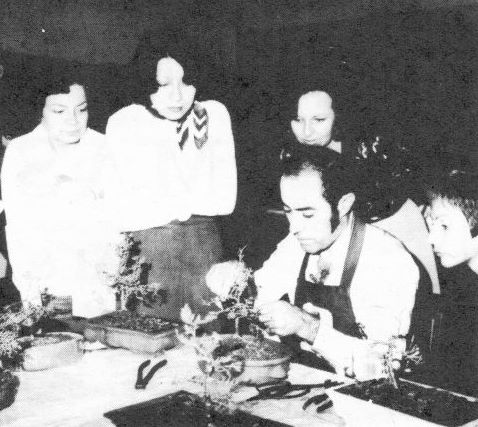
"Jorge Lucero conducting a workshop in Lima, Peru. Trees are Thuja occidentalis. Jorge was
(Biography and personal e-mails from Jorge Lucero to RJB Sept 12 and 13,
2006; American Bonsai Studio) SEE ALSO:
May 2, Jul 10, Sep 22, Nov 1
assisted by Betty S. Henderson. Photo by Betty Henderson and courtesy Florida Bonsai Magazine" (Bonsai Magazine, BCI, July/August 1978, pg. 205) |
||||
| 2 |
1994 -- George Gray of Dallas, TX died at age sixty-one. (He
"first became interested in bonsai in the 1940's, when Ming tree lamps
and table ornaments were all the rage; I didn't know the real thing
existed until years later when I was wondering around the streets of
Seoul, Korea, on R & R. It was there I saw a beautiful little
[zelkova] forest of trees in a shallow, oval tray. Time
passed. I came home, moved into my first apartment, started
playing with plants, and never thought there were other 'nuts' like
myself. When I moved to Dallas, I gave my collection to friends
and started again. I had not been making any real progress for
three or four years, when I happened to take one of my potted azaleas
to work. There, the program chairman of a local garden club saw
my plant -- and thus started my involvement with bonsai." For
thirty-five years George was very active in the bonsai
community. He, long-time friend Arch Hawkins, and three others founded the
Bonsai Society of Dallas
in 1965, and later they travelled to Austin to assist
in the formation of that club. George served two terms as
Director of the American Bonsai Society, and contributed several
articles to the ABS
Bonsai Journal. He operated The Watering Can, a Dallas shop specializing
in bonsai, ikebana, and Oriental antiques. He taught, lectured, and conducted
collecting expeditions for bonsai from his home base in the Southwest. He was co-chairman, with
Arch Hawkins, of the 1995 Symposium to be held in Dallas, the second at
that venue. [Ironically, Arch also would die shortly before the
Symposium was held.])
(Bonsai, BCI, June 1970, pg. 11)
|
||||
| 3 |
|
||||
| 4 |
1910 -- Gloria Frances Stewart was born in Santa Monica,
California. [She would change her name to Gloria Stuart when she
was a stage and film actress chiefly in the 1930s and 40s. Her
second husband would be Arthur Sheekman, a writer of several films,
most notably assisting with the Marx Brothers' early movies.
Gloria would first pay attention to bonsai one evening at dinner at Joe
Cohn's, an old friend from Arthur's MGM days. She would be
fascinated by Joe's centerpiece -- a classic bonsai in an antique
Chinese pot. Joe would acknowledge that it was one of his own and
he had been studying for many years with Frank Nagata, the dean of
bonsai masters in Southern California. She would begin to study
bonsai under Frank Nagata, every Sunday afternoon at Nagata-san's home
downtown, in the early 1970's with about seven other students, ages
twenty to eighty. This would be in his small lath house, with
their little trees in front of them, watching Nagata trim and wire his
tree. Gloria would take up bonsai with a passion partly because
she had no place, no earth in which to garden at the time. Her
mother's family had been dirt farmers, and Gloria hungered for a
garden. (She had had some flower gardening experience during the
previous decades at other houses.) With bonsai, at least she
could have growing things around her on the apartment's patio.
Soon she would have over one hundred miniature trees set along the
patio wall. A long-time friend, Susan Marx, wife of Harpo and a
stage actress herself in the 1920s and on film in the 1930s, would
study bonsai with Gloria. Once one of Gloria's grandchildren
would ask that she bring her bonsai and potting tools for a
show-and-tell at his elementary school in Malibu. She would
demonstrate how these little giants were trained and shaped -- that the
point was one (that is, you/a tree) can survive with grace and beauty
and strength no matter what Nature throws at you. The children
were completely simpatico -- it was so rewarding! A dozen years
later, that same grandchild, Benjamin, and Gloria would find themselves
strolling through the royal forest surrounding the palace at
Fontainebleau, near Paris. On their walk, they filled their
pockets with French black oak acorns. When she got home, she
would plant them as three bonsai forests. Seventeen years later,
the tallest trees would be eighteen inches high, their leaves, instead
of being a man's palm size, were two to three inches wide. "And,
true to my bonsai master's dictum, in their arrangement, there is space
for the birds to fly through." Gloria's bonsai -- and the friends
that come with it -- among them John and Alice Naka, Frank and Margaret
Goya, Kay Komai, Joseph Locke -- would long be an abiding comfort and
joy. Gloria would keep busy traveling, designing and printing
artist's books, painting, giving parties, and exhibiting her
bonsai. One show in particular would be the California Bonsai
Society's 1997 show, where she'd have a Sawara cypress. According
to the Bonsai Exhibit info sheet, her tree was number 4 (of 20): "Ms.
Stuart is a retired motion picture actress, and her bonsai reminds you
of a petite Shirley Temple, one of the many famous actors that Ms.
Stuart co-starred [with]." This would be about the time publicity
for the film
Titanic
began. She would go on to receive the Oscar® for Best
Supporting Actress playing Old Rose. During the banquet at the
5th WBFF World Bonsai Convention in Washington, D.C. in late May of
2005, she would introduce a video that celebrated John Naka’s
contribution to the National Bonsai and Penjing Museum and the world of
bonsai.]
(Stuart, Gloria with Sylvia Thompson
Gloria Stuart, I just kept hoping
(Boston: Little, Brown and Company; 1999), pp. 191-192, 217, 231, 278;
"The Marx Brothers Biography: Adolph Arthur 'Harpo' Marx,"
http://home.earthlink.net/~morewebspace6/harpo.htm
; "World Bonsai Convention,"
NBF Bulletin, Summer 2005, Vol. XVI, No. 1,
http://www.bonsai-nbf.org/nbf/vol16no1.pdf)
SEE ALSO: Sep 26 and this
tribute
by Cheryl Manning
2000 -- The Hawai'i Bonsai Cultural Center in Waimanalo opened to coincide with the BCI Convention held in Honolulu from July 5 through 8. Founders Walter and Ann Liew have been collecting and cultivating bonsai for almost 50 years. In 1998 the couple moved to a 20-acre agricultural lot and developed the Center along with the adjacent Dragon Garden commercial bonsai nursery, which holds thousands of plants, pots and rocks. More than 400 specimen dwarf potted trees are on display at the Center. A retired furniture store owner, Walter grew up in northern China and moved to Taiwan when he was 13. It was there that he became interested in penjing and began collecting. Through his years in Hawaii as a businessman and teacher since 1976, Liew expanded his collection, both by growing bonsai in his Wai'alae Iki yard, and later by purchasing plants and other penjing pieces on many trips back to Taiwan and China. ("HomeStyle: Museum of mini trees" by Mike Leidemann, http://the.honoluluadvertiser.com/2000/Jul/06/islandlife1.html ; "Hawaii Bonsai Culture Center" by Pamela Farris, Honolulu Weekly, May 16, 2001 reprinted on http://bonsaiculturecenter.com/BonsaiArticle.htm ; personal e-mail to RJB from Walter Liew, March 19, 2002) |
||||
| 5 |
1929 -- Koji Amakawa was born in Japan. [In May 1944 he would
start to work at the Japan National Railroads, but in Dec. 1961 he would
change occupations to bonsai. He would then establish the Tosho-en
Nursery at Ryuzan in the Chiba prefecture. Many masterpiece bonsai
would be trained by him using precise cultivation and shaping techniques.
His own, unique style would be impressed on the design of powerful coniferous
bonsai. Playing an active part in organizing important local bonsai
exhibitions, he would contribute much to the development of the Japanese
bonsai world. He would also hold a Buddhist order priesthood at the
Shingonshu Toyamaha Fudohin.]
("IBC '77 Chicago, Crossroads
of the World Convention News,"
Bonsai Magazine, BCI, September 1976, Vol.
XV, No. 7, pg.210; "Demonstrators at World Bonsai Convention April in Omiya,
Japan,"
Bonsai Magazine, BCI, Jan./Feb. 1989, Vol. XXVIII, No. 1, pg. 27)
1995 -- Takeo Fukuda, the third president of the Nippon Bonsai Association, died at age 90. He was also the first president of the World Bonsai Friendship Federation. ("Takeo Fukuda," http://en.wikipedia.org/wiki/Takeo_Fukuda) SEE ALSO: Jan 14, Oct 20. 2002 -- Masakuni Kawasumi, president of Masakuni Co., Ltd., died at age 78. (Born in 1923 in Kawaguchi, Saitama Prefecture, where he was educated, he was introduced to bonsai early in life because of the work of his tool-making father, Masakuni I (1880-1950). The younger later spent three years in the U.S. growing and experimenting with and writing about local species of trees. In 1975 he said "America bonsai is still in its infant stages and you have not had the experience of long years of cultivating bonsai as we in Japan. This, I feel, is a great advantage, for just as a pet takes on the disposition of its owner, so bonsai in the United States will reflect the personality of American enthusiasts. When the American personality becomes expressed in bonsai, it will be the turn of the American bonsai to go abroad with the ambition of being recognized for both its reputation and its beauty. This, I am sure, will take place in the near future." The Masakuni Co.'s bonsai tools have long been held in high regard for their quality.) 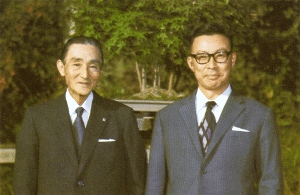
Kyuzo Murata and Masakuni Kawasumi, 1975
("The Bonsai World Loses a Leader," in "News and Events,"
http://www.bonsaienthusiast.com/newsevents.htm,
accessed Oct. 3, 2002; Bonsai with American Trees by Kawasumi, dust jacket notes; Hanford Bonsai Society,
http://www.gsbf-bonsai.org/hanfordbonsaisociety/News/2000/Nws00_02.htm,
accessed July 4, 2004)
|
||||
| 6 |
|
||||
| 7 |
1921 -- Leo Raymond Ball was born. [He would enter the USN JLS from Berkeley,
California, on July 2, 1942, after he'd have graduated that spring from
UC Berkeley. Ball would graduate from the
US Navy Japanese/Oriental Language
School at Colorado University at Boulder in the 36-person (possibly the
largest such class) Class 10 in July 1943 as an Ensign,
USNR. The one year immersion course
would bring many of the 1300 attendees to appreciate and admire Japanese culture. Ball would not have been
unique among the graduates of the US Navy JLS/OLS who served during the Occupation of Japan, many would go on to
write of admiring Japanese gardens and bonsai. However, Ball's brief involvement with
Kyuzo Murata on a day in late November 1945 would arguably change the course of
history for bonsai in Japan. Ball would die years later on July 16, 2007 at age 86 in Fruitvale, Mesa County,
CO, near Grand Junction on the western side of the state.]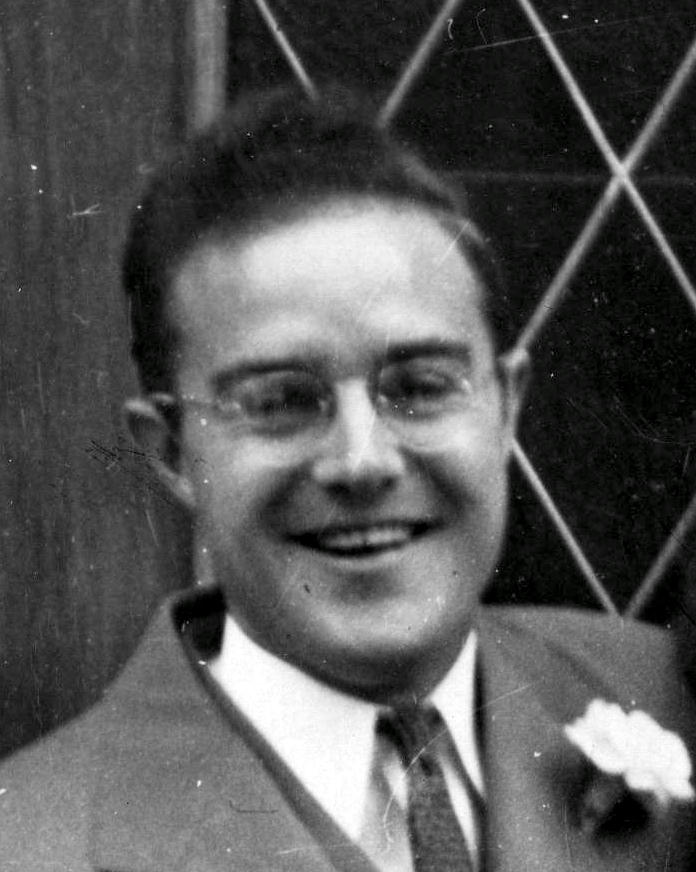
"Our only shot of Leo Ball, on his wedding day, Pineau, 29_03_02_01, AUCBL."
("Leo Ball," http://www.faqs.org/people-search/leo-ball/#ixzz22huj6Lpw;
"A JLO & Bonsai Gardens", The Interpreter, (#181, March 1, 2013), pg. 4,
http://ucblibraries.colorado.edu/archives/collections/jlsp/interpreter181.doc;
private e-mails from David M. Hays to RJB, 20 and 23 Jul 2012; McGinnis, George P. Naval Cryptologic Vets,
Turner Publishing Company; 1997, pg. 38; we are researching the other members of Ball's class to find in-print
admirations of Japanese gardens and bonsai.) SEE ALSO: Jan 15, Nov 24
("A JLO & Bonsai Gardens", The Interpreter, (#181, March 1, 2013), pg. 4) 2000 -- Hong Kong Baptist University opened the Man Lung Garden at the main Li Promenade of the Shaw Campus to promote the Chinese heritage of penjing and enrich the lives of all who view it. The garden is initially displaying 20 pot plants donated by Dr. Wu Yee-sun, founder of Wing Lung Bank. The Wu Yee-sun Charitable Foundation has made a donation of HK$2 million for the promotion of penjing through the existence of the garden. Dr. Wu is widely regarded as the Sage of Penjing for his decades of in-depth expertise and reputation as the leader of the Lingnan School of Penjing. The original Man Lung Garden was founded by Dr. Wu in 1967. At that time, the garden was a place where penjing lovers and experts came to talk about and show their unique pot plants. The public had the rare opportunity of seeing beautiful exhibitions of priceless miniature trees. Unfortunately, in 1978 the first Man Lung Garden was forced to close down due to the expropriation by the government of Hong Kong of the land for a railway station. ("Penjing Garden opens on Baptist University campus," http://www.hkbu.edu.hk/~ours/pr_99/pe070700.htm ; "About Man Lung Penjing," http://www.manlungpenjing.org/eng-about.html) SEE ALSO: Mar 16, Mar 27, May 2, May 11, Dec 14 |
||||
| 8 |
1936 - Son Harold was born to Taketo Sasaki, a
Nisei Japanese coffee farmer in Kona, Hawaii.
[Harold would be the oldest of seven children, four boys and three girls. His early fascination with trees
in containers would begin when his father pointed out a juniper planted at his birth. Growing up on a
coffee farm he would trim trees on his family's land. At age 18, Harold would pick up a pamphlet, "Enjoy
the Four Seasons Through Bonsai," and he would read it three times before sunset. He would then "take the
plunge" in 1955, committing himself to the art of bonsai, starting with tropical and ornamental plants.
Enjoying the four seasons would prove difficult in Hawaii, so Harold would move to the mainland, earning an
associate's degree in forestry from a community college in northern California. He would then move east to
attend Colorado State University, but as he would have no affinity for organic chemistry, he would drop out of
CSU, and settle with his wife, Marcia, in Wheat Ridge just
west of Denver. There they would raise two children, son Eric and daughter Lisa. Harold would work
briefly as a stockbroker in the Mile-High City. Discovering that many native plants of the Rocky Mountains
were good material for bonsai -- including Ponderosa pine and Englemann spruce -- Harold would join the
Rocky Mountain Bonsai Society, and later would serve as its
President in the late 1970s. He would become a Director of the American Bonsai Society for six years during
the 1980s. In 1985, Harold would expand his hobby to a full-time business,
Colorado Bonsai Limited, selling trees to enthusiasts across the
country. (Marcia would be a registered nurse who does holistic medicine and would help her husband with
his business.) Harold would then regularly conduct classes and lectures in several Colorado locations, in
addition to lectures and presentations from coast to coast. Conventions he would demonstrate at would
include the joint ABS-BCI Washington, D.C. 1986; the BCI Minneapolis/St. Paul 1987, Memphis 1992, and Toronto
1997; and the ABS Denver 1997 and Milwaukee 2002. This nationally recognized expert teacher would become
famous for his "photosynthesis talk" in which he would emphasize the importance of light for the health and
growth of bonsai indoors and outdoors. Sasaki would also teach bonsai classes at the
Denver Botanic Gardens and at his own greenhouses. He would
direct the growth of trees using wires and the Sasaki Bonsai Training Ladder, a simple device he would
patent in 1993. His mission would ultimately be to
"demystify" the art, debunk the myths and provide "Bonsai Survival 101," so that this wonderful Japanese art can
be enjoyed by all. (Harold's father would live and garden in Hawaii until the age of 103 years and 9
months. His mother would die in a car-pedestrian accident at age 67 or 68.)]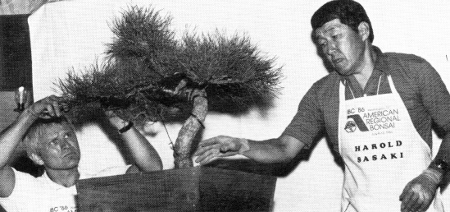
Harold Sasaki (right) with assistant [Larry Jackel] after his demonstration at International Bonsai Congress,
July 1986, Washington, D.C. (Bonsai Magazine, BCI, Vol. XXV, No. 6, November/December 1986, pg. 20) 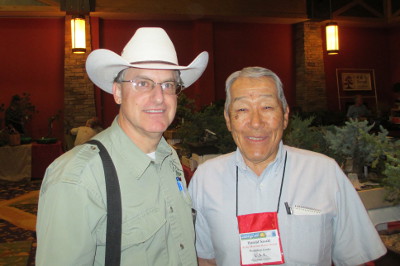
RJB and Harold at the ABS/BCI Convention in Denver,
(Conversation with Harold by RJB 04/12/2008, Pikes Peak Bonsai Society meeting; conversation with Harold by RJB
06/19/2010, Rocky Mountain Bonsai Society show; conversation with Harold by RJB 06/23/2012, ABS-BCI Convention;
"Harold Sasaki,"
http://www.cincinnatibonsai.com/harold_sasaki.htm;
Hovendick, Briana "Branching out - Bonsai gardener sees life through the trees," MileHighNews.com, Apr.
12, 2007,
http://www.jeffconews.com/Articles-i-2007-04-12-190682.112112-Branching_out.html;
"Harold Sasaki," http://www.zoominfo.com/#!search/profile/person?personId=8306987&targetid=profile.)
June 23, 2012 (Photo by Kenny Asher) 1996 -- Norman Nelson died at University Hospital in Tamarac after a lengthy battle with cancer. He was 71. He had been a horticulturist in South Florida for the past forty years, and a lifetime member of several bonsai societies. He was survived by his wife, Mary, a sister, 2 daughters, 2 sons, and seven grandchildren. He was preceded in death by another son, who died at age 28 in 1986 after a seven-month battle with cancer. A memorial garden ("The Koro-En" aka "Garden of the Shining Dew") was built on the Morikami grounds -- where Norman worked for 10 years -- by the Nelson family and friends in memory of that son, Daniel. [It would eventually be renamed Nelson Family Memorial Garden for Norman Nelson and sons Dan and Bob, all of whom tended the Morikami Museum's landscaping and bonsai during its early years.] ("Norman, Nelson," http://articles.sun-sentinel.com/1996-07-10/news/9607100097_1_funeral-services-pompano-beach-collins/4; James, Sallie with Carol Lewis "Norman Nelson, Curator Of Morikami's Gardens," http://articles.sun-sentinel.com/1996-07-09/news/9607080309_1_nelson-family-bonsai-mr-nelson; "Morikami Museum and Japanese Gardens," http://www.heathermccurdy.com/archives/2011/03/morikami_museum.html) SEE ALSO: Feb 24 |
||||
| 9 |
1932 - Jack Wikle was born. [Jack would grow up on a farm; his father
would have grown up on a farm in the mountains of West Viginia and would take some forestry classes up at the
Agricultural College of the State of Michigan
as a supervisor for the CCC, and his
mother would grow up on a farm in southern Michigan. The couple would buy a farm they could afford, 40 acres
with a variety of fruit trees that Jack would climb up into. During the years of WWII, they would then buy
an 80-acre farm in southern Michigan with a river running through the woodland of willows, beech trees and an odd
sycamore. Jack would go on to get a degree at Michigan State as a biology
student and, like his mother, would be a teacher. Upon graduation he joined the U.S. Army for a two-year
stint for the Korean War. He'd wanted to stay in the States, but would end up being sent to Japan where he
very quickly would become enchanted with the country. He would see his first bonsai at a small exhibit
during his 17-months there, but knew he could never create these because he had the wrong cultural background.
While working at a nursery back home, he would go back to Michigan State to get a master's degree in ornamental
horticulture, his thesis being "Moisture Relationships and Container-Grown Nursery Stock." A visit by Jack
and his wife Jeanine one week-end to a bonsai collection in Michigan by a non-Japanese (!) nurseryman encouraged
Jack to try his hand at the small compositions. His host would pass on the one "secret" before Jack left:
"you have to have a soil mix that really grows roots." [Jack would get a job at the Davey Tree Expert Company in Kent, OH in their "Technical Service Department, the college-educated teacher would be in their winter foremanship school. A book in the Tech Service Depart library about bonsai would start Jack thinking. A tree meeting down south at Georgia's Callaway Gardens would have Jack hear a throw-in speaker, a newspaperman lecturing on "interesting trees." George F. Hull would have just written a book, Bonsai For Americans (Doubleday & Company, Inc., 1964, a different volume than in the Tech library). Within four years a display of bonsai at Hidden Lake Gardens would begin shortly after the hiring of Jack as the Gardens' first Education Specialist. Already a bonsai hobbyist, Jack would readily accept an invitation to display a few of his "little" trees in one corner of the Conservatory Temperate House, having recently joined the Cleveland Bonsai Society. As of 2021, Jack would be the longest active member of the Ann Arbor Bonsai Society, joining that group and quickly accepting officer responsibilities in 1974. He would be repeatedly recognized for his early and ongoing contributions to that organization. Within the bonsai world, Jack would probably be best known for his pioneering efforts, beginning in 1976, in growing very small bonsai -- mame, lit. "bean" -- indoors, relying completely on cool white fluorescent light. In 2022, he would have some trees grown 40 years under fluorescent light with no outdoor vacations and no periods of dormancy. Jack would serve as Program Chairman for two of the American Bonsai Society's Annual Conventions in the 1980's, and in 1985 would conduct a workshop on mame trees and give a lecture on mame under flourescent lights at the ABS in East Lansing, MI. Two years later he would conduct a mame workshop at the Bonsai Clubs International Convention in Minneapolis/St. Paul, MN. Having been on the ABS Editiorial Committee since 1981, Jack would subsequently edit the ABS Quarterly Journal for four years, 1988 through 1991. (During the last two years, Jack would serve as RJB's first editor, on "Hachi-No-Ki, A Perspective" and then "Some Bonsai Futures." It would be Jack who would suggest that the second article should be published first as a stonger introduction of RJB to the bonsai community. Due to space and time constraints, "Hachi-No-Ki" would be passed on to Jack's successor, Arch Hawkins, for publication in 1992.) [Jack's contributions to the ever-increasing community of bonsai artists in the United States would be beyond measure. His modesty about the scope of these endeavors would be equally impressive. He would be speaker and exhibitor at a number of national-level events. In addition, he would teach classes regularly, conduct bonsai workshops, do hundreds of in-person presentations and write dozens of articles on bonsai subjects, including at least 20 for ABS between 1982 and 2002, and one each for International Bonsai in 1996 and Bonsai UK Magazine in 1997. In 2010 Jack would be a participant in the Mid-America Bonsai Alliance Convention in Grand Rapids, MI. The collection at Hidden Lakes Garden would grow over the years thanks to Jack's personal involvement with the bonsai world and his generous capacity to share his extensive knowledge and enthusiasm with others. Gifts from numerous accomplished bonsai artists would increase the collection to more than 75 trees. Jack would guide volunteer help in styling the trees and maintaining them for optimum health and beauty. The Bonsai Courtyard would have display pedestals that would accommodate between 18 and 20 bonsai, offering visitors an opportunity to engage at close range with a pleasing variety of impressive trees and to reflect upon the beauty and wonders of nature. There would be the countless one-on-one "collaborative interactions" between Jack and individuals seeking his help and wanting to learn. These interactions typically, would involve two people learning together as bonsai artists. Jack's assessment of these sessions, "Our trees were helping us grow." The Jack Wikle Bonsai Legacy Fund would be created in 2021 in cooperation with the Lenawee Community Foundation, to provide support for the maintenance and display of the Bonsai Collection at the Michigan State University's Hidden Lake Gardens. The fund would also be used for the promotion of this living artform locally, nationally and internationally. Still going strong at age 90, Jack would be seen in this Bruce Baker video (with a number of Jack's larger trees seen during the last 6 minutes) and Parts One and Two of Dave's Bonsai video.]
Jack & Jeanine Wikle, 06/19/2006
("Jack Wikle: American Bonsai Artist In His Own Words,"
Bruce Baker, 2022 ; "Jack Wikle,"
"About the Fund," and
"The Collection," Jack Wikle Bonsai Legacy ;
The Indices, 2004)
SEE ALSO: Jan Also, Apr 25, Nov 21
(Photo courtesy of Alan Walker, 05/11/07) 1976 -- The official dedication ceremony took place of the Japanese Collection of the National Bonsai and Penjing Museum at the U. S. National Arboretum in Washington, D.C. Japan's gift to the U.S. Bicentennial consisted of fifty-three bonsai and six treasured viewing stones. ("How the Japanese Collection was Assembled," http://www.bonsai-nbf.org/japan/assembly.htm ; see also pp. 41-44 of Dr. John Creech's The Bonsai Saga, How the Bicentennial Collection Came to America) SEE ALSO: Feb 19, Mar 20, Jul 21, Aug 6 |
||||
| 10 |
1957 -- The Pittsburgh Bonsai Society was organized by a
group of students who had been learning bonsai "theory" from Mr. A. E. Kemmerling who taught at
Schenley Park. (The local story was that A. E. Kemmerling started creating bonsai trees before he ever heard of the art. As a small boy, he had made a tiny town with the usual tiny toy cars, roads, houses, etc in his back yard, but he wanted little trees to make it more realistic, and -- after long, long experimentation -- he succeeded. He found a reference in his fifth-grade textbook to the Ming trees of ancient China. Fascinated by the thought of potted trees small enough to be carried about, he began (in his own words) killing hundreds of plants in an effort to find the techniques used to miniaturize them. Some years later he came across a book dated 1876 on dwarfing fruit trees. With this in hand and with the vast horticultural knowledge his experiments brought him, he began travelling a path parallel that of the Japanese bonsai experts. Later, of course, he was very knowledgeable, and devoted to the art. In 1954, he began to teach bonsai courses through the City of Pittsburgh parks and the Phipps Conservatory. As years went by, the city was said to be the only municipality to provide instruction at no charge to the students of this creative and sincere art. In 1970, still under his direction, the City of Pittsburgh courses would be 16 weeks long, entirely free, and a new class would begin immediately upon the completion of the previous class. Later, as a very old man himself, he would die in or just after an attempt to save a handicapped man from a fire.) ("Do You Know Me?," Pittsburgh Bonsai Society, April 2001 Newsletter, http://pittsburghbonsai.org/pbs_B004.htm; personal e-mail 30 Jun 2009 to RJB from Mary Floyd, whose three sons had their eyes opened "to nature in general (as well as creating excitement about bonsai) in a way that few city kids are fortunate enough to experience" by this "natural educator and a very great gentleman."; Bonsai Magazine, BCI, May 1970, pg. 13) 1995 -- Father Paul Bourne, O.C.O. died at the Monastery of the Holy Spirit in Conyers, Georgia, where he had spent the past 47 years of his life. (Born in 1908 in Seattle, Washington, he had been exposed during his youth to the art of bonsai through a Japanese neighbor and on his subsequent trips to China and Japan in the 1930s. Before the priesthood he studied art from ballet dancing with Martha Graham to painting and sculpture at the Sorbonne in Paris. His Masters Degree from Yale was in Art and Architecture. At the monastery in 1963, Brother Paul built a glass and wood-framed greenhouse to house orchids, which he grew and displayed as a hobby. He also began puttering around making bonsai, although he had no formal training. Bonsai was pursued as a personal way of solitude, meditation and prayer. The first "sale" of a tree happened one day while Brother Paul was away from the greenhouse. Upon his return, Brother Pius, who ran the small monastic gift shop, confessed that he sold one of the "little plants" to an insistent customer. It was Brother Paul's favorite and Brother Pius had charged all of five dollars for it. From this unlikely start the bonsai business began. Soon enough, pilgrims from near and far began asking to buy his "little trees." Brother Paul began a pioneering journey that strongly influenced the growth of bonsai throughout the Southeastern U.S. and elsewhere. He transcended the canons of traditional bonsai, referring to his style as "American Bonsai." One of the characteristics that set him apart was his use of a rock, placed advantageously with almost every tree he worked on. The result was always the same: a very natural and pleasing setting. This particular trait created an encounter with Frank Okamura, from the Brooklyn Botanic Garden, during a workshop in Atlanta. Observing a bonsai done by Brother Paul, complete with the usual rock, and referring to the definition of bonsai, Frank said, "Bonsai say no rock, you must remove rock!" To which one would imagine Brother Paul probably answered,"My bonsai say YES rock!," as indeed the rock did stay in place.) ("Eulogy To A Bonsai Friend" by Jorge Lucero, Bonsai Magazine, BCI, September/October 1995, Vol. XXXIV, No. 5, pg. 51; Bonsai by the Monastery website: http://www.bonsaimonk.com/frpaul.html) SEE ALSO: May 2, May 5 |
